36. Puzzles made by Puzzly (UK): Part 1
An essay about the British laser-cutter Puzzly Company (UK) and a review based on three puzzles made by that company. First of two parts. (about 5900 words; 39 photos)
Introduction
I apologize for the long delay since my last postings. It took me quite a while to recover from the big binge of writing that my Christmas Music project involved, and then I finally got to the front of the queue for some eye surgery, took a trip to visit my granddaughters (and see a solar eclipse), and various other diversions. And that was all in addition to getting carried away doing research inspired by the artwork on these three puzzles and my usual procrastination. The research led to this essay getting to be too long so this is another two-part installment. Part 2, to be posted in a couple of days, will report about what my research into the images revealed.
I am not affiliated with the Puzzly Company except as a paying customer, but I did receive a free puzzle from them: When I ordered two puzzles Amelda graciously also gave me a third puzzle that represents one of their more recent and creative cutting styles. Possibly she recognized my name and remembered thoughts I have expressed online about my preferences in cutting styles. Both Amelda and Craig helped me write this by participating in a Zoom-meeting interview and responding to e-mailed questions.]
Part 1 – this newsletter
· Introduction
· Puzzle images and data
· The Puzzly company
· The review
· Puzzle assembly photos and commentary
Part 2 – Research about the images
· Introduction
· Guildford High Street - vintage Raphael Tuck & Sons postcard; artist unknown
· Bouquet of Flowers on a Ledge - by Ambrosius Bosschaert the Elder, 1619
· Two Women by the Shore, Mediterranean - by Henri-Edmond Cross, 1896
The Puzzle images and data
puzzle name: Guildford High Street
puzzle stats: 250 pieces 36cm x 25cm (3.6 cm²/piece) 3+mm MDF
ribbon grid cut with 20 thematic whimsies, one of which is multi-piece
image: a vintage Raphael Tuck & Sons “oilette” postcard ca. 1912; artist unknown
puzzle name: Flowers in a Vase
puzzle stats: 500 pieces 51cm x 36cm (3.6 cm²/piece) 3+mm mdf
ribbon grid-cut with 28 thematic whimsies, one of which is multi-piece
image: Bouquet of Flowers on a Ledge
painted by Ambrosius Bosschaert the Elder; 1619
puzzle name: Mediterranean Summer
puzzle stats: 200 pieces 51cm x 36cm (3.6 cm²/piece) 3+mm mdf
creative geometric cutting design with figural elements
image: Two Women by the Shore, Mediterranean
painted by Henri-Edmond Cross; 1896
The Puzzly company
The Covid pandemic was a time when many people found themselves both without income from their regular employment and with a lot of time on their hands. Puzzly is one of several home-workshop laser-cutting puzzle companies that were founded during the first two pandemic years. Some of those Covid start-ups have already closed down, some have developed to become their proprietors’ full-time businesses, and others like Puzzly have continued as thriving side-gigs for their founders.
When the Covid pandemic hit hard in March 2020 Amelda and Craig Astfalck were running Ecopare, a consultancy company that they had founded in 2010. That company assesses the environmental performance of schools, commercial, and industrial facilities. they then identify opportunities and implement solutions to improve their clients’ long-term eco-efficiency, especially by reducing energy consumption. One of their projects is reported to have saved a large automotive company £750,000/year in energy costs by converting its midlands-based factory to LED lighting.
But in that fateful month Britain implemented a particularly stringent nationwide pandemic lockdown which prevented them from doing most of their consultancy work. It was unclear when that business would be able to pick up again. Like so many other people, Amelda and Craig were forced to stay at home and they quickly tired of reading and screen-oriented entertainment and turned to assembling jigsaw puzzles. Both of them had long-time experience with assembling them; the usual cardboard ones, old vintage hand-cut wood ones, and laser-cut wooden puzzles made by the Wentworth Puzzles. By April they were beginning to muse about starting their own puzzle company, both to provide income until Ecopare could pick up steam again and also as an outlet for their creativity. By Summer it began to feel like their destiny.
The process of starting up a new company in an entirely different field than that in which they had experience and expertise must have been a daunting one. What’s more, it meant going against formidable competition. In Britain, for most people making wooden puzzles meant only one company at that time – the huge Wentworth Wooden Puzzles Company. In 1995 Wentworth had been the first company in the world to make laser-cut puzzles commercially, and for over ten years they had the worldwide market for making them to themselves.
Beginning in 2005, beginning with Liberty Puzzles in the US, a few other laser puzzle-makers became established in other countries. But in 2020 Wentworth was (probably) still the largest wooden puzzle maker and in the UK they were still the only company that was competing against cardboard to make wooden jigsaw puzzles that were affordable for most people. (The country had and still has a rich heritage of craftspeople who make hand-cut jigsaws, but that cutting technique is very labour-intensive and the puzzles cost much more than comparably sized laser-cut ones.)
Amelda and Craig had to overcome many learning curves before they could get into production. On the puzzle-making side of things, among the first big steps was learning about the technology and equipment they would need. That included acquiring a computer-controlled laser cutting machine. They would also need a specialized printer and a heat-press to affix the image securely onto the wood.
Buying professional-grade equipment involves a lot of research. They bought a used laser-cutting machine in December. Then there was learning how to use that new gear; for example, they would need to learn through experience how to adjust both the cutting machine (to ensure that it works optimally without over- or under-burning) and upgrade its exhaust system to avoid having smoke fumes settle back as discolouration on the puzzle pieces.
They also needed a professional grade printer, one that would be suitable for printing both the puzzles themselves and the boxes. Research also included finding out what kind of printing is fade resistant, what size of printer would be large enough, and what kind of paper makes for a durable image layer on puzzle pieces that will be subject to a lot of handling.
And they needed to find reliable sources for that paper as well as plywood and cardboard (for the boxes) in the year when the phrase “supply chain problems” entered the international vocabulary.
In addition to all of those manufacturing issues, Craig took on the challenge of learning the techniques of puzzle-design, including how to develop challenging but accessible cutting patterns and attractive-yet-sturdy figural pieces, and on top of that learning how to use the software that converts hand-drawn designs into digital instructions for a cutting machine.
Add to all that, Amelda and Craig were committed to making products following best practices for energy conservation and sustainability, but at least that was an area where they already had expertise. A wooden jigsaw puzzle is inherently an eco-friendly product. The puzzle itself as well as its packaging is a carbon sink for the lifetime of the puzzle. If pieces don’t get lost or damaged they can last for many assemblies over hundreds of years.
You can read about some of the choices they made to achieve their eco-friendliness objectives here and here. One example is that they decided to make all of their own boxes – that helps keep both their costs and carbon-footprint for transportation down. They designed boxes that have home-printed paper glued onto dense 100% recycled cardboard that they cut to shape with their laser machine.
Even the unbleached cotton bag that comes with all of Puzzly’s larger puzzles is a carbon sink and its role is more than just to make the puzzle seem more elegant. One of the biggest risks to the lifespan of a jigsaw puzzle is lost pieces. A bag helps prevent that from happening. (If there is sufficient extra space in the box I often put my favourite puzzles into cotton bags made from my worn-out shirts.)
All of that learning and decision-making came before they could begin making puzzles to sell! But “after many failed attempts of designing, cutting and boxing our puzzlies” over a year after they had decided to start the business Amelda and Craig were ready to go to market. In November 2021 they launched their website and began selling six small Christmas-themed puzzles at local craft markets. Since then they have expanded their offerings considerably. They now have 41 different puzzle images, many of which are available in multiple sizes.
Each of their puzzle offerings has its own unique cutting design, usually including figural pieces that thematically relate to the image. They have learned from selling face-to-face at markets that different people want different degrees and kinds of challenges so Craig uses four distinctly different general styles of cutting. These range from the traditional ribbon cutting that one associates with cardboard puzzles (but with figural pieces mixed in) to one that he calls the “house style” (which is really his opportunity to mix and match various cutting tricks and a vehicle for inventing new ones.)
Selling their puzzles at local and regional craft markets is their primary marketing channel. Besides keeping their environmental footprint down that way they enjoy seeing the reaction that their wooden jigsaw puzzles elicit from people who have only ever seen cardboard ones before, and meeting and getting face-to-face feedback from folks who have previously bought their puzzles.

As I write this, Puzzly has now been in active operation for about 2½ years. As with all wood puzzle companies, demand is highly seasonal. (I heard from the owners of two other established puzzle-makers that over 80% of their income is in October through December, but both of those companies’ business models primarily depend on online-sales.) Amalda and Craig still primarily sell their puzzles at fairs and markets.
Face-to-face sales account for about 80% of their volume although the proportion of online sales is growing. Many of their online sales come from people who were first introduced to Puzzly at one of their market appearances. As far as I can tell, Puzzly doesn’t currently do online advertising although Amelda does participate in a the British Wooden Jigsaw Puzzle Group on Facebook and posts announcements on Instagram. It was the great buzz that they were getting about their puzzles in that Facebook group that inspired me to order my puzzles from this small British company.
After the Covid pandemic faded Amelda took over the main role of running Puzzly and Craig largely returned to managing their Ecopare company, with puzzle designing being his side-gig. But during the pre-Christmas season (Oct through Dec) last year they participated in 20 craft markets. Business was so brisk that even though he set aside design work he still had to temporarily stop taking clients for Ecopare and Puzzly became a full-time job for both of them.
I see from Amelda’s online posts that they participated in a number of Springtime markets this year. I presume that they will also be quite busy with Summertime markets and craft fairs, which I presume would make their sales volume somewhat less seasonal than the online-only companies.
I asked Amelda and Craig about their future plans. The reply I got was:
At the moment [our] two businesses are running side by side . . . Puzzly is not ready to stand on its own two feet at the moment as we are reinvesting the revenue back into stock and capital equipment, or bootstrapping, as we call it. As a young company you need to give it at least 3-4 years to mature to see what returns it can give. All our indicators are showing that it has great promise . . .
So I would say the medium term plan is to continue to scale up organically. We know there is a point in the near future that we will need to provide a big investment in capital/labour to get us to the next level & we are working on plans to make that happen.
The review
The majority of their puzzles is what I think of as the British style and their puzzles are nominally 3 millimetres thick. Therefore, as with my Dec 1022 review of the then-newly-revived Victory brand of puzzles, the huge Wentworth Wooden Puzzles company seems to be the most appropriate standard of comparison for this review. In many ways that is not at all fair. Puzzly is a small company working from a home workshop and Wentworth is the most experienced and (probably) the world’s largest manufacturer of laser-cut wooden jigsaw puzzles.
By my measurement, with their paper layer Puzzly puzzles are about 3.5 mm thick. For most of the Wentworth’s history their puzzles were 3 mm thick – originally made from plywood but switching to medium density fibreboard (MDF) at about the turn of the century. About 1½ years ago they switched to a 4 millimetre thickness. As I have often mentioned in this series I prefer the richer tactile feel of thicker puzzles, but that is in the context of comparing puzzles that are 3 or 4 mm thick to ones that are in the 5 to 6 mm vicinity. Puzzly is currently experimenting with offering some of their newer puzzles in both nominal 3 and 4 mm thicknesses, charging a premium for the thicker option.
Because of its size and long history Wentworth has a huge selection of puzzles with many hundreds of puzzles in their catalog representing many styles of artwork. That is one area where Puzzly cannot match them. It has only been in business for about 2½ years now and as I write this they have 41 puzzle images in their offerings. My three puzzles are just a small sample of their diversity of artistic styles.
Puzzly has a small but good selection of 10 vintage and 9 fine art images, tending to be lesser-known paintings by famous artists rather than their iconic masterpieces. For example, while many companies offer puzzles with images of Gustav Klimt's The Kiss, Puzzly has a 480 piece puzzle with his less sell-known Portrait of Adele Bloch-Bauer I. Both are from Klimt’s iconic golden period. But most of the Puzzly images are contemporary artwork. As shown above, some of them are Craig’s own illustrations. The company seems to be trying to replicate Wentworth’s catalog in the sense of having something for everyone, but I think that they do a better job than Wentworth at including images for people with more contemporary pop culture tastes (such as fans of Freddie Mercury.)
Another factor in which Wentworth has the edge is that their cut-lines do not show up as prominently as the lines on the Puzzly ones that I assembled. It is not that my I assembled were substandard in this regard; more like they are run-of-the-mill while Wentworth is particularly good in the technical aspects of laser cutting (but not as outstanding as the laser cutting done by some of the more expensive brands like Stumpcraft and Hidden Piece Puzzles, whose cut-lines are practically as invisible as those in hand-cut puzzles.)
I have noticed that over-dark cutting is usually more common with newly-established puzzle-makers and I bought my puzzles quite a while ago now when Puzzly was still newly established. So I asked whether this is an issue that he has since been resolved. Here is Craig’s reply:
The short answer is yes! It took a while to work out why it was happening as it is a laser beam focal point issue – which creates a wider cut (and we are talking of 10ths of a millimetre) at point of entry through the puzzle.
Puzzly’s packaging aims to go head-to-head against Wentworth. Except for mini-puzzles they provide a storage bag as well as a sturdy box. However Puzzly’s handcrafted boxes are not as perfectly made as the ones that come off of Wentworth’s mechanized assembly line. Two of my three boxes had bubbles under the paper, and all of them had an untidiness in how the paper which holds the box bottoms together is affixed at the corners. I forgot to ask if this is another issue that has since been resolved. But in any event, these aesthetic shortcomings in box fabrication will not affect their ability to safely store the puzzles throughout their lifetime. I tend to see this as a reminder that these puzzles are made at a small scale in a craft workshop rather than in a large factory.
One of the ways that Puzzly counters Wentworth’s strengths is by charging less for their puzzles of similar size. In the very popular 250 piece size the regular price difference is currently fairly minor (£29.50 for Puzzly compared to £32.00 for Wentworth.) But for bigger puzzles there is a much larger difference. For example a standard 500 piece Wentworth now costs £63 while the regular price for a comparable sized Puzzly is only £49.
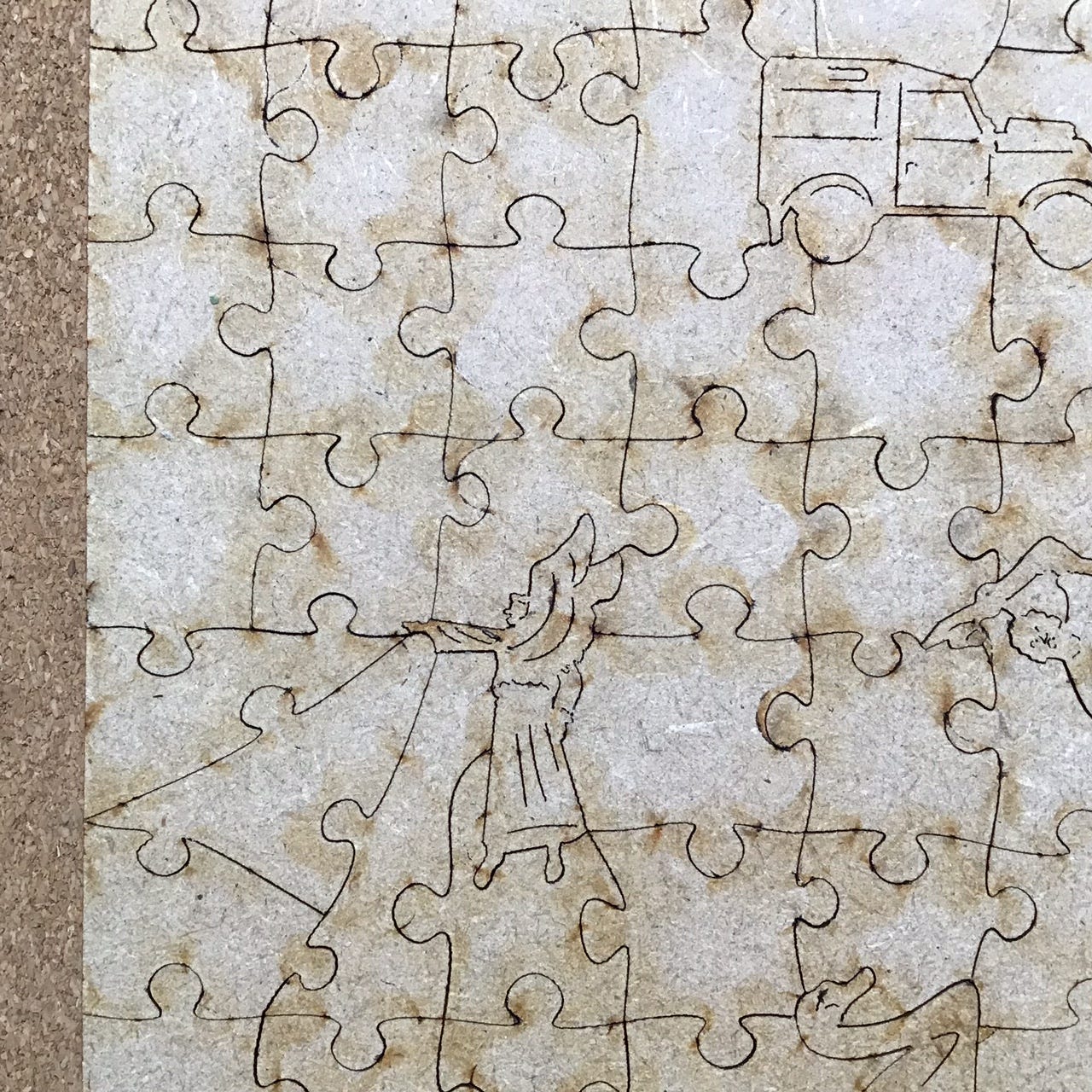
Another is that while both companies make puzzles with tessellated cutting designs as well as cutting that Puzzly calls “irregular” (and Wentworth calls “free form”), Puzzly’s offerings include two more styles that are not available from Wentworth. One of these is a very simple cutting style that they call “traditional.” It basically is four-square ribbon cutting (as is found in inexpensive cardboard puzzles) but with figural pieces scattered in. They also have a sophisticated Puzzly “house style” cutting that is more creative than anything that Wentworth currently offers (unless such cutting is included in their new “extra difficult” category that I haven’t tried yet.)
I have often criticized Wentworth’s most common cutting style (irregular ribbon cutting, based on vintage Victory puzzles from the 1930s) as being too simple for my personal tastes and not taking advantage of the creative opportunities that laser cutting enables. But Craig told me that “a very large portion” of the people they meet at craft markets have never seen or done a wooden jigsaw puzzle before, and even among those who have “we find many people don’t want too irregular of a cut.”
I can understand that. Although they don’t suit my usual preferences, Puzzly’s simple “traditional” cut puzzles with whimsies might be an even better initial introduction to wooden puzzles for newbies than Wentworth’s usual style. And even though I am becoming an experienced wood puzzler with a preference for puzzles that challenge me, sometimes simple puzzles can be fun or more meditative than challenging ones. They could be right for anyone depending on one’s mood.
The Puzzly “house style” features more exotic cutting and the Mediterranean Summer puzzle that Amelda gave me to review is one of them. I’ll tell a bit more about that one below in this review, and more yet at the end of this posting after a Spoiler Alert. Basically, it upends the distinction between whimsy and non-whimsy pieces, and has a surprise element using a geometric trick; (no, not tessellation!)
Figural pieces (AKA whimsies) add an element of fun to jigsaw puzzles, but they also enable building islands around their distinctive outlines. This makes puzzles easier to assemble than if whimsies were not included. The more intricate the outline shape of the whimsies are, the more that they make the puzzle easier. When figural pieces for jigsaw puzzles were first introduced in the early 20th century they were simple but intended to be recognizable silhouettes. Back then, the figural pieces rarely matched the theme of the puzzle. They were generally chosen by the cutters based on which ones they were capable of cutting reliably and quickly.

No laser-cut puzzle-maker makes whimsies that are as crude as those shown above. Computer-controlled laser cutting enables much more intricate shapes than hand cutting and it also enables interior accent lines that clarify what a figural piece is even if its outline shape is not self-evident. This enables depicting things that cannot be identifiable from a simple silhouette.
But accent lines also tend to draw attention away from the overall image after the puzzle is assembled. I get the impression that Craig’s whimsies tend to have both more intricate outline silhouettes and more accent lines than Wentworth puzzles. Switching my standard of comparison, Puzzly whimsies are more like those in laser-cut puzzles now made by the re-launched Victory company.

Ideally, the subject matter of whimsies complement the subject matter of the image, and enhances the “story” in the image. Many of the figural pieces in Wentworth puzzles only have a tangential relationship to the image, and they frequently re-use the same whimsy patterns in many puzzles. All of the figural pieces in Guildford Main Street relate to the town of Guildford, with many of them being local landmarks. The relationship of many of the figural pieces to Flowers in a Vase is less apparent unless you know that the 17th century Dutch infatuation with flowers was part of a broader craze of obsession with nature (as I learned from my research – see my report about this painting in Part 2.)
On balance, I think that the quality of Puzzly’s workshop-made products are nearly as good as the ones made in Wentworth’s large manufacturing facility, with the difference made up by them being at a lower price point. In both cases their online ordering software is easy to use and shipping fulfillment to me in Canada has been timely. The cost of delivery to North America from Great Britain is considerably less that the cost of shipping from other European companies (and in fact, the cost of shipping from there to Canada is less than the cost of shipping from the US.)
Wentworth has an excellent reputation for customer service (e.g., for the rare occurrence of broken or missing pieces.) I have had no reason to need Puzzly customer service for such issues (which is a good sign in itself) but from my communications with Amelda I get the impression that she would also be very good addressing such issues satisfactorily.
Puzzle makers vary in how much they tell you about the cutting style for various puzzles in their catalog. A few either show a photo of the puzzle in its dissected form or they give a somewhat detailed description so that you can assess whether the cutting style suits your preferences. Some companies avoid giving this kind of information, which some buyers might consider to be “spoiler.” On its website Wentworth’s write-ups include at least one photo that shows the cut-lines of a completed puzzle.
The images on the newly-revised Puzzly website show the artwork without cut-lines and also an image of loose pieces spilling out of the bag featuring selected whimsies. The write-ups now describe the general puzzle’s cutting style with the words “traditional,” “irregular,” “tessellation,” or “house style” (which Craig has told me is a catch-all where he gets to experiment with novel cutting techniques and tricks.) But you need to understand their vocabulary to know what that means and it is only useful for people with previous experience of Puzzly’s puzzles since such terminology is not standardized across brands.
In the case of Mediterranean Summer, for example, the write-up acknowledges that it has a decorative irregular edge (but the photos only show the full original painting) and the description says that its cutting is “house style” and “is made up of wonderful irregular shaped jigsaw pieces that repeat across the puzzle.” That that gives little hint that it has special surprise cutting tricks that I found to be very intriguing (more about that below.)
Personally, I prefer to get more information about cutting design when I am shopping because that is a very important factor in my puzzle purchases (but then, as I have often said, my puzzling superpower is forgetfulness so this information is not a spoiler for me.) I ordered them from Puzzly’s previous website, which did not identify categories of cutting style. As mentioned above, the two puzzles that I originally ordered – Guildford High Street and Flowers in a Vase – are the “traditional” cutting style that is not what I prefer. Frankly, I would not have bought them if I had known that although i must admit that I did enjoy them and found assembly to be more meditative than assembling more challenging puzzles.
If I had ordered such puzzles from Wentworth I would take full responsibility for having made a sub-optimal choice for my personal tastes since I would have seen (or, at least, would have been able to see) the cutting style before ordering. I now know that if I had looked more carefully at the non-whimsy pieces poured out near the mouth of the bag in one of the pictures on the Puzzly site I could have avoided selecting the rather simple ribbon-cut style of puzzle, but that is a rather subtle thing to look for.
Just as it was once standard practice not to let customers know what the image of a puzzle would be (but that practice has now nearly been completely abandoned) puzzle makers now face a policy choice about how much information to give potential buyers about their cutting styles. I am pleased that the recently revised Puzzly website now includes the information that such puzzles are “traditional” cut, especially now that I know what that term means for Puzzly. But personally, I think it would be a service to Puzzly’s customers to include on the website a glossary describing their four cutting styles mean, and in the case of “house style” puzzles, give some clue as to what makes its cutting unique or special. As a customer, my personal preference would be to actually see the cutting pattern in a photo.
In any event, Amelda certainly made up for whatever disappointment I had due to not knowing that the puzzles I bought were “traditional” by having added the free Mediterrannean Summer puzzle to my order.
Images on the puzzles
Besides cutting design, the image is an essential element in determining whether a puzzle turns out to be an enjoyable build for anyone. As discussed above, this is the factor about which buyers have the most fore-knowledge and they can self-select to ensure that a puzzle suites their tastes. It is also very personal, so I try to avoid basing my reviews on whether or not I enjoyed the artwork.
Guildford High Street was the first Puzzly puzzle that I assembled and I must admit that I was somewhat disappointed in it. I had been attracted by the subject matter streetscape but had not carefully examined the photo of the image on the website. It has an overall dark dreary sepia cast to it, and due to the image’s source, a lack of sharpness. As will be discussed in Part 2 the artwork comes from an “Oilette” postcard that was printed over 100 years ago. When blown up to the 36 x 25 centimetres (14” x 9¾”) puzzle size the pixilation of the original printing and diffusion from the oilette coating results in a haziness in the puzzle’s image.
I suspect that this nostalgic image is included in Puzzly’s offerings primarily for its appeal to Guildford residents and tourists. But my dissatisfaction with the image is all on me – I selected it and I can’t say I wasn’t warned: The sepia shades and haziness of the puzzle image are accurately shown in the photo on Puzzly’s website.
Guildford High Street and Flowers in a Vase were both fun puzzles to assemble within the limitation that they both have the “traditional” style of cutting that I feel I have outgrown. Of the two, I preferred Flowers in a Vase, partly because of the added challenge of its 500 piece size but mainly because it has a much more crisp, clean image with bright, cheerful colours. As a bonus, the images of both of these puzzles inspired very interesting research (see Part 2, my next newsletter.)
When I was selecting puzzles to buy I very much liked the image of Mediterranean Summer but was afraid that its pointillist style would make it too challenging for me as a puzzle. I like to use lines and brushstrokes as well as colour and fit to correctly place my pieces. I was wrong. The dabs of colour in this image are large enough to aid in assembly and they use a confined palette. I had no problems with false fits.
Composition is an important element in fine art paintings, and Mediterranean Summer is one of the most well-known works by one of the foremost pointillist artists (see my research in Part 2.) Craig has chosen to give it an irregular edge, which is a very popular cutting technique that adds challenge. The edge pieces become more difficult to recognize making it harder to approach assembly with an “edges-first” strategy.
Personally, I don’t think that fine art paintings are very suitable for having irregular edges because they can draw attention away from the artist’s intended composition of the artwork. And in this case, a cutaway that is part of the irregular edge intrudes on an understated sailboat that may or may not be an important element in the image. (This analyst interpreted that boat to be what the standing woman is gazing at, but I don’t see it that way. I think she is looking at a large steamboat in the far distance recognizable in the painting only because of its smoky trail.) [Note: the cutaways on the 420 piece version of this puzzle do not obscure the sailboat.]

Puzzle assembly – Spoiler Alert
The following photos show the cutting designs of these three puzzles, which is information that Puzzly does not include on its website. In keeping with their approach I have decided to put all three of these assemblies under a Spoiler Alert. However because Guildford High Street and Flowers in a Vase are in the rather simplistic “traditional” cutting style, my in-process photos and seeing their back sides is unlikely to provide much information that would aide in assembly so it is probably safe to read further.
On the other hand, as noted above, think that the cutting design for Mediterranean Summer is something that is best left as a surprise. If my above comments have already persuaded you to buy that puzzle (as I hope they have!) proceed with caution when you get to that section.
In my usual manner, I assembled these puzzles without referencing the images on their boxes: In fact, I had covered up those images with Christmas cards when the puzzles first arrived to prevent accidently being reminded of them. I took progress photos of my assembly for all three puzzles but completed this report some time later and I had not written down any notes about my strategies and impressions except for Mediterranean Summer, so my commentary here is rather skimpy.
Guildford High Street
It became pretty apparent while flipping and sorting that the cutting of this puzzle is grid style, and a particularly four-square grid style at that. Since this cutting style is similar to typical cardboard jigsaw puzzles I used the common strategy of starting with the edge pieces and working inward from there. I took a few breaks from that by building islands around the whimsies and other targets of opportunity based on colour.
Flowers in a Vase
I knew that assembling this 500 piece puzzle would require using a side-board as well as my large 22” x 34” (56 x 86 cm) board for my initial flipping and sorting. I put all of the numerous predominently-blue pieces on the side-board, and loosely colour-sorted the other pieces on my main board. That left me a generous amount of working space in the middle. Apparent edge pieces were lined up on both boards. It was obvious that this puzzle also had a four-square grid style ribbon cutting design.
I began with the darkest blue edge pieces, anticipating (correctly) that they would be sky on the top of the puzzle:
Then an idea occurred to me. The size of this puzzle when completed (as stated on the box) would be almost as large as my side-board. So I decided to try an experiment. I would use the small board as my assembly board. I still used the working space on the large board to make sub-assemblies (islands) but could move them to the assembly board by sliding the islands onto thin Christmas cards.
Mediterranean Summer
Spoiler alert reminder - I found that much of the enjoyment of this puzzle was in discovering the secrets of its cutting. I recommend that you do not read further if you already plan to buy it.
Since this puzzle was only 200 pieces I didn’t even try to separate the edge pieces while sorting. I did do a basic colour-sort, putting the light coloured pieces upper-left and the especially dark ones bottom-left.
While I remembered that Amelda had said that it was a “different cut” than the other ones I did not know what kind of different it would be. A few things about this puzzle became readily apparent. Not only was it obviously not grid cut, it doesn’t have any of the knob style connectors. It did have lots of sweeping curves and very few apparent edge pieces.
I didn’t mean to begin by assembling the edge but when I began with the dark pieces a semi-irregular edge is what developed first. The orientation of the people in the image confirmed that this was the bottom side of the puzzle.
When I turned my attention to the light pieces some edge pieces again led the way. I began to suspect that this might be another puzzle that had quadrilateral symmetry (see my report on Rocky Mountain Creators’ Cabin in the Woods puzzle here.) Some of the light-coloured pieces were exactly the same shape as dark ones, and there seemed to be a lot of laterally symmetrical pieces.
This next photo was taken fairly soon after the previous one. Things developed quite quickly once I realized that the top and bottom mirrored each other.
Actually it isn’t fully quadrilaterally symmetrical like Cabin in the Woods. The large circular medallion with a large cicada whimsy in the middle is only bilaterally symmetrical.
With only 200 pieces this was not a very challenging puzzle but it was a lot of fun. I highly recommend this one, but in the 420 piece size.
As mentioned above, the irregular edge’s cutaway upper curl on the right side of this version of the puzzle hides the sailboat. Craig sent me the following photo of the back side of the 420 piece version. I can see that the shallow side cutaways in that version would not hide the sailboat.
I asked Craig where he got the idea/inspiration for his Mediterranean Summer cutting design. Here is his reply:
For me I see Henri-Edmonds art not so much as the people in the work but of how he depicted nature and the landscape. For the puzzle you can feel the Mediterranean heat, hear the cicadas and smell the herbs … just like in the middle of summer at the Med. The organic forms of the trees and bushes also directed me to have a ‘nature’ based cut with flowers, insects and stems/ tendrils. As there is a lot of symmetry in the cut it lent itself to be mirrored.

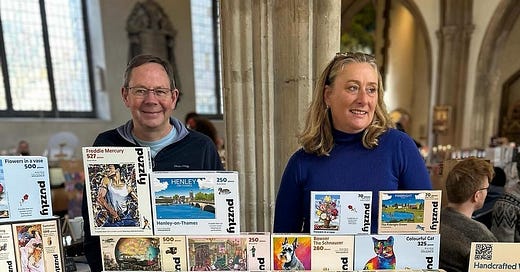


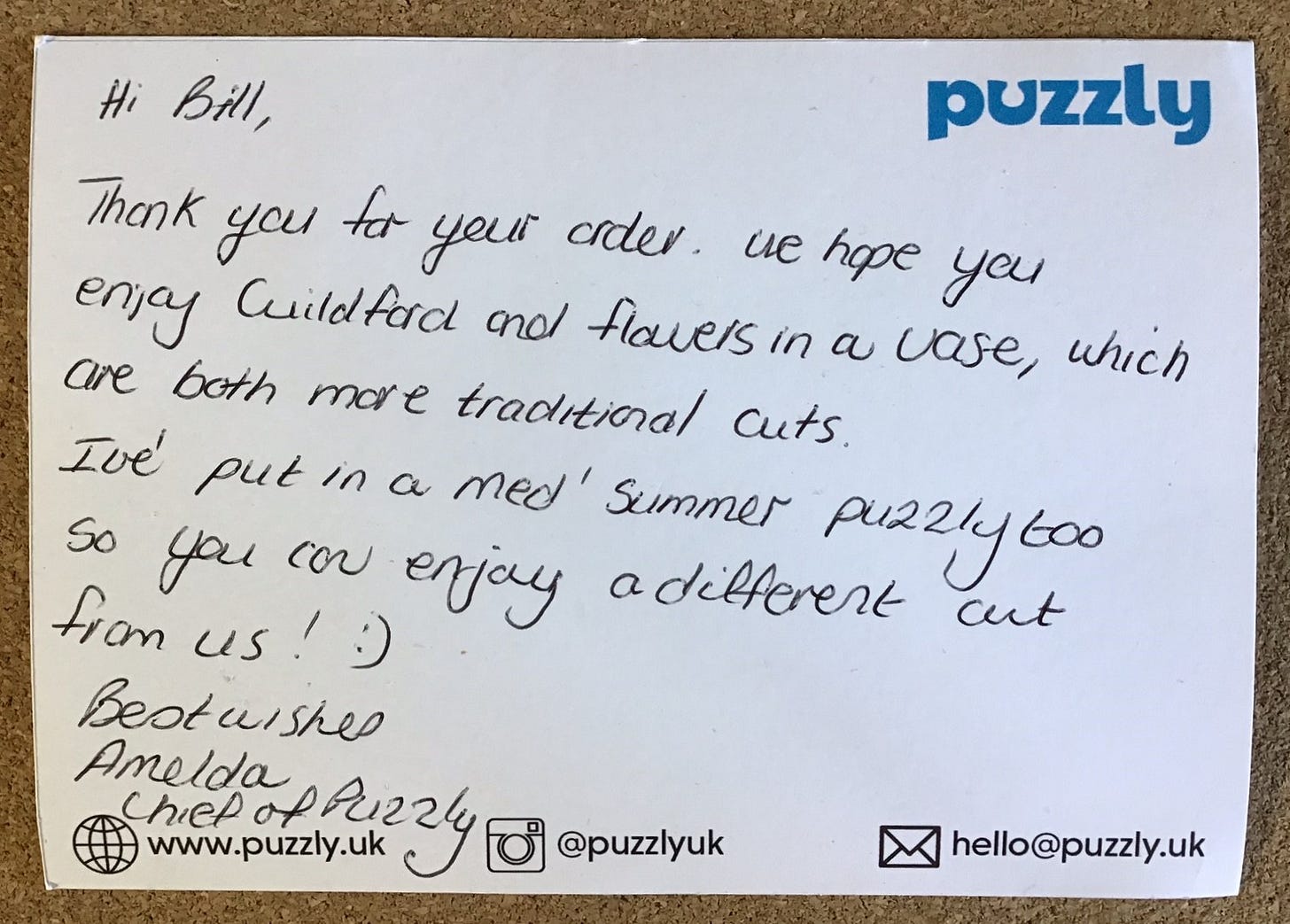
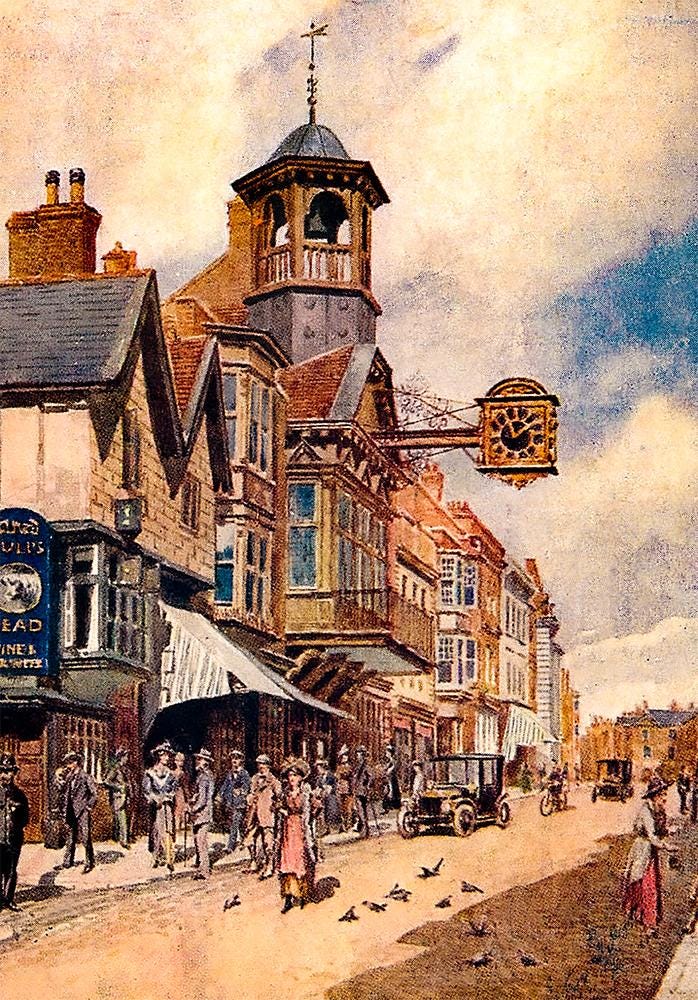
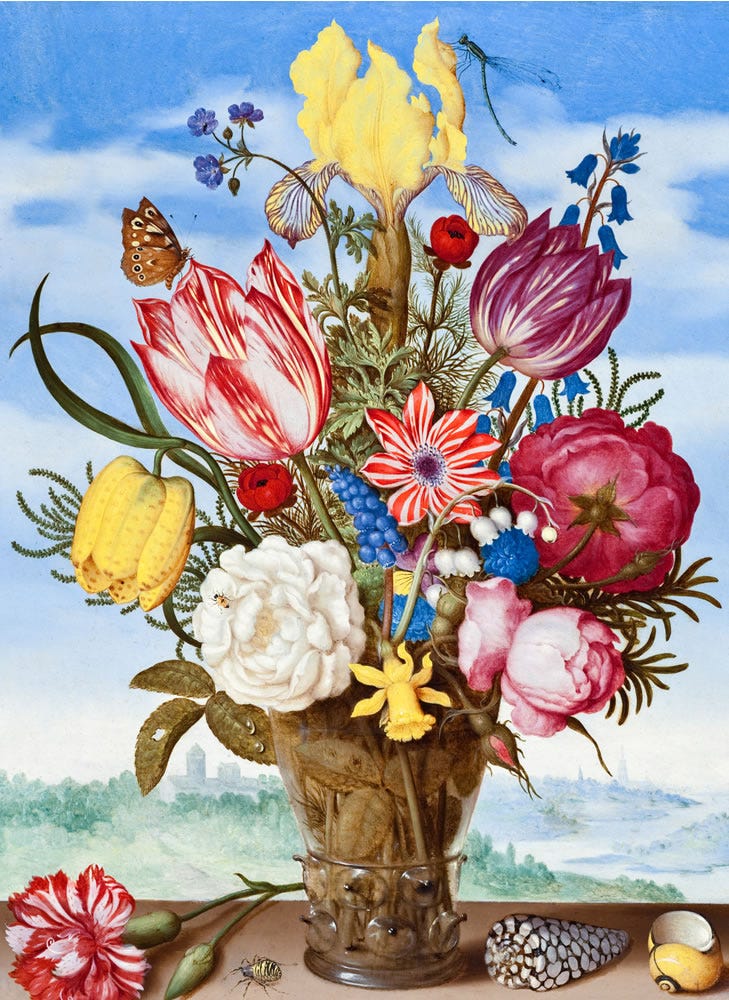
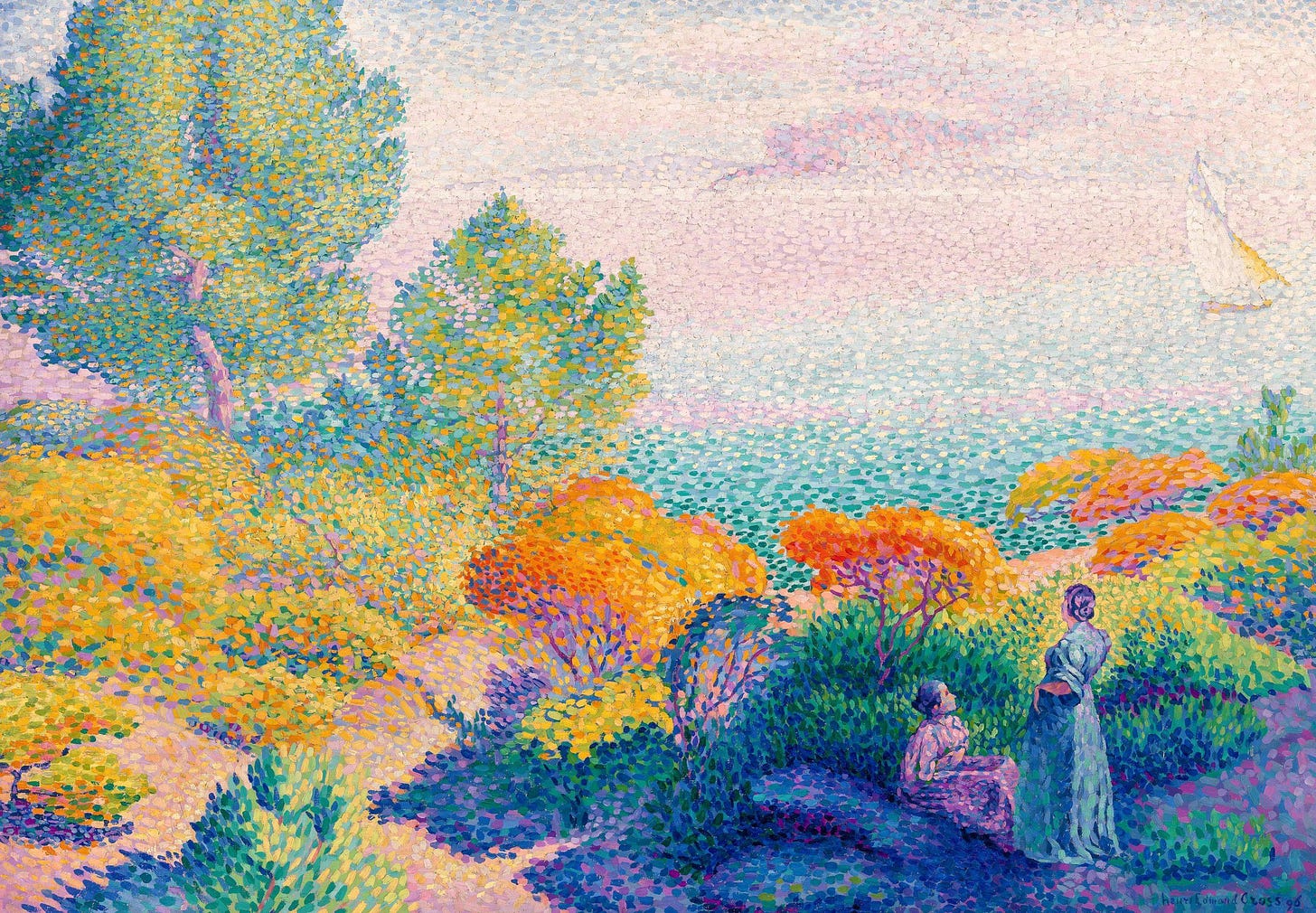
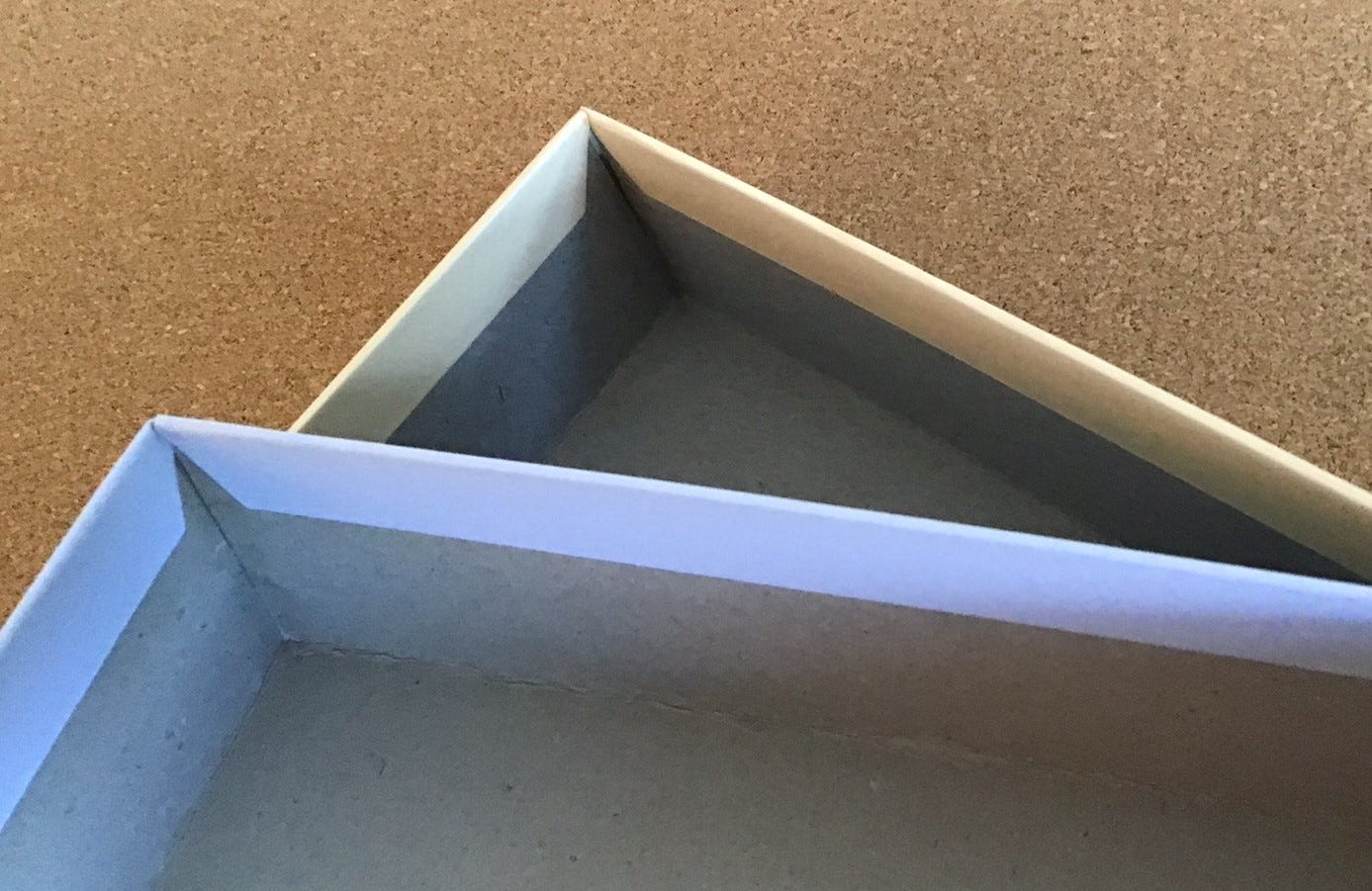
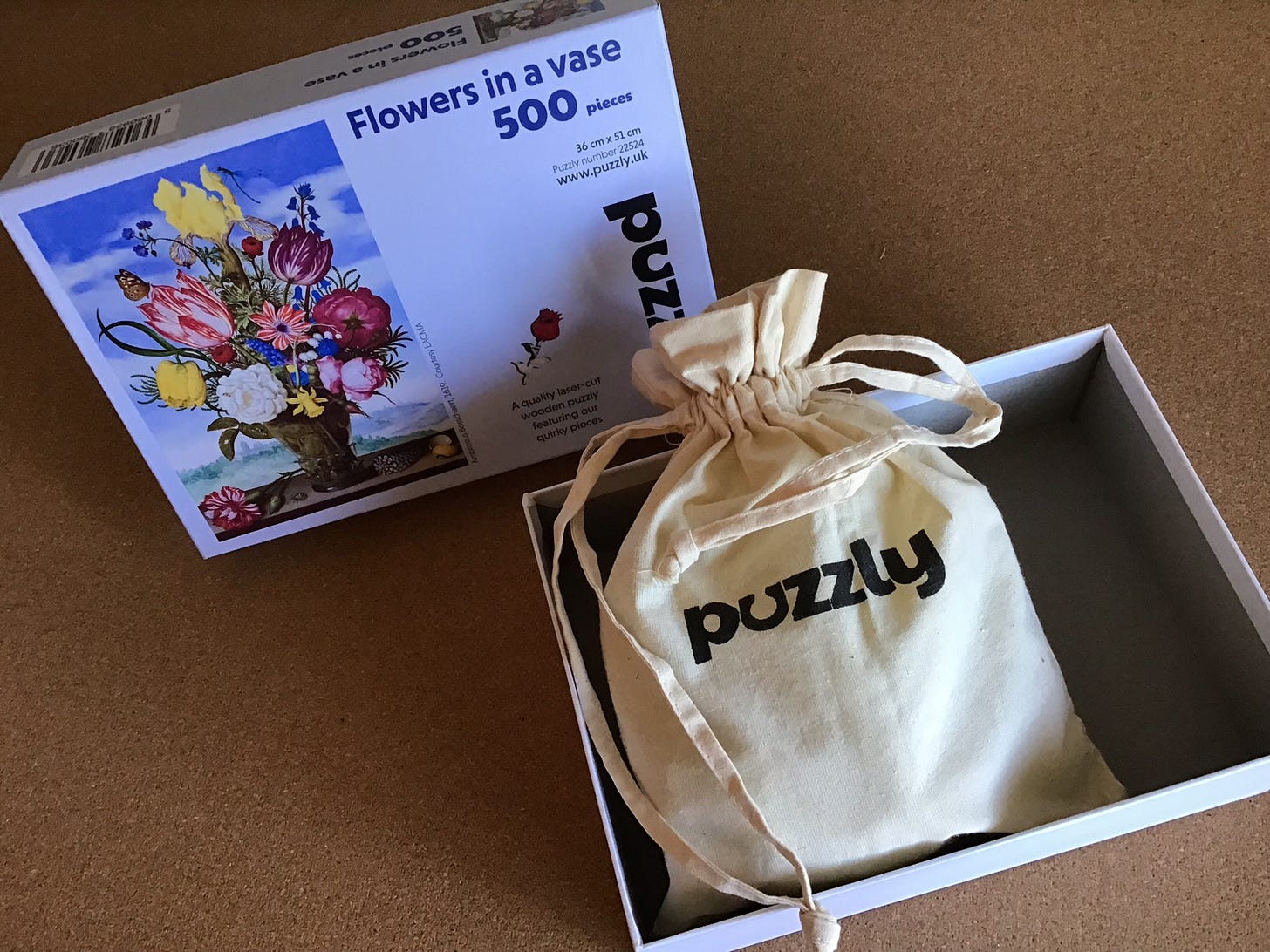


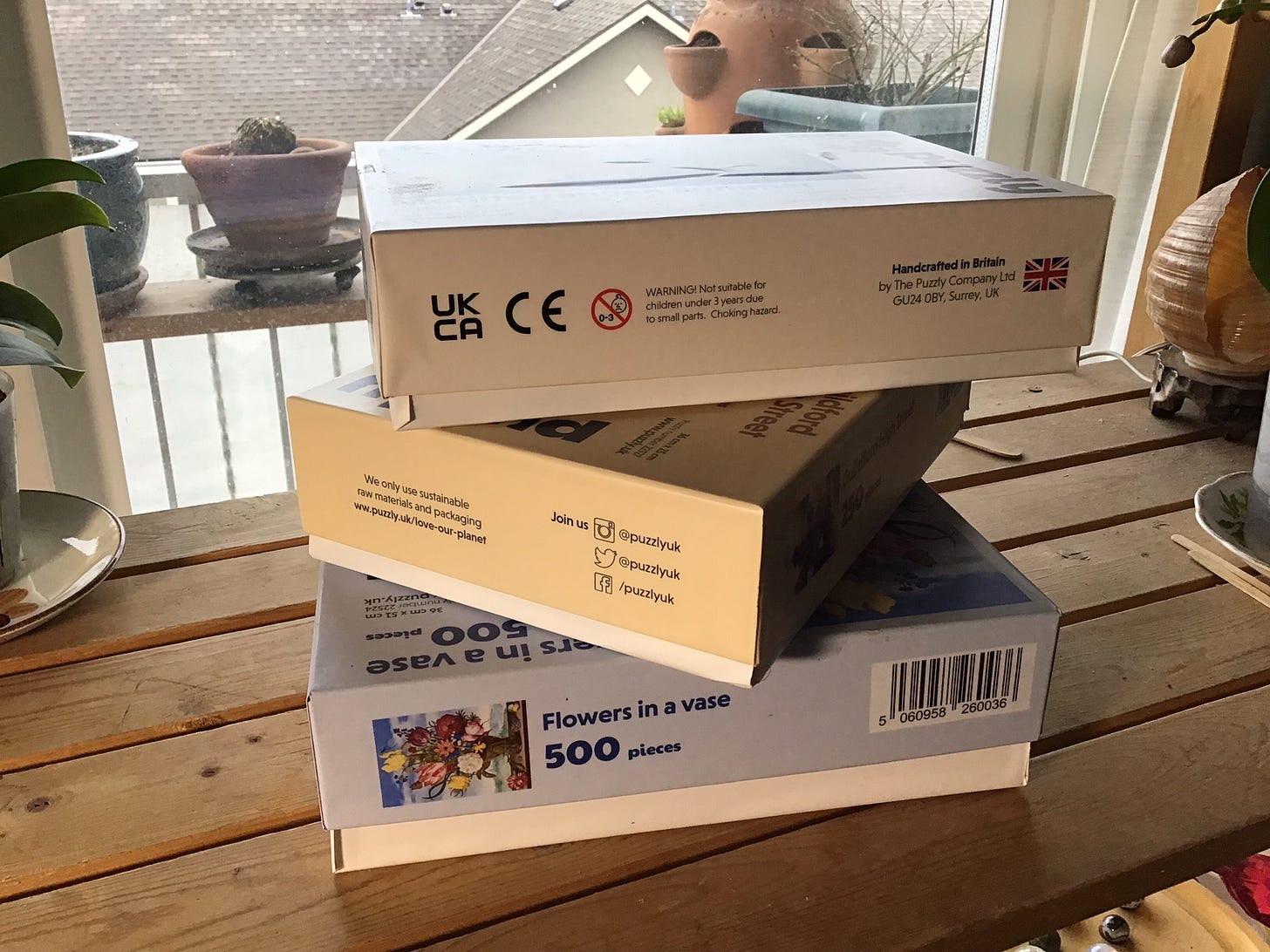





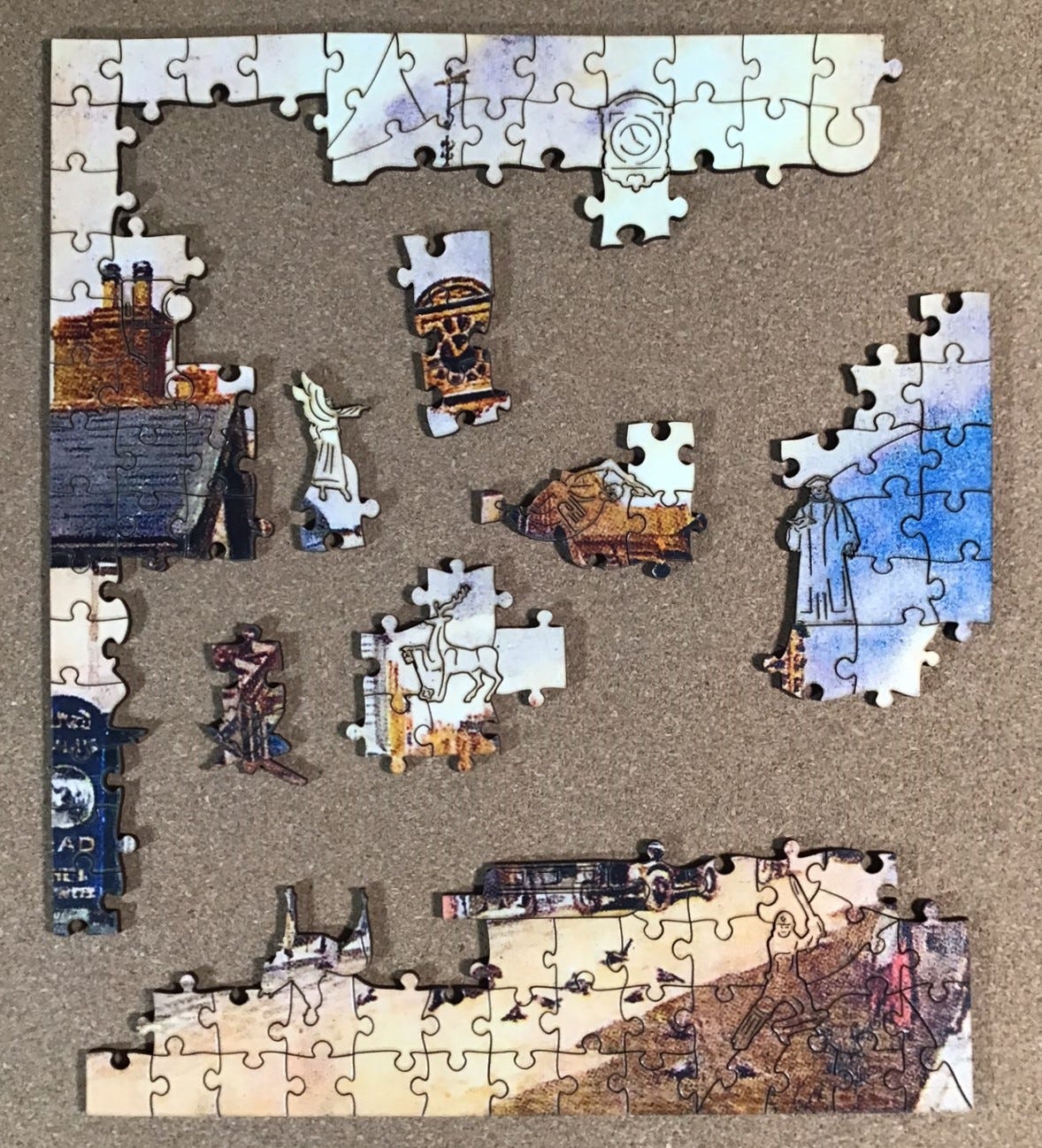
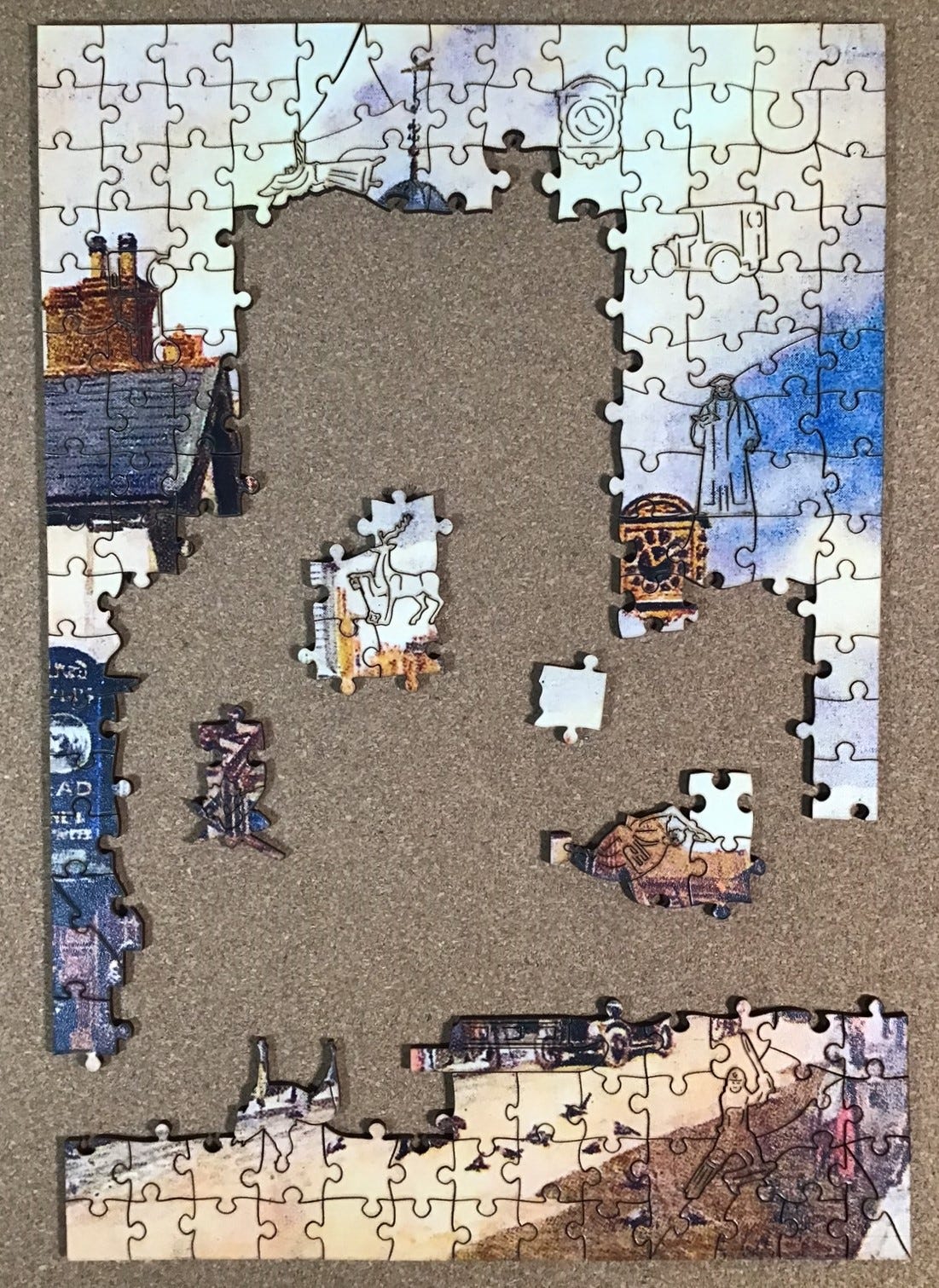



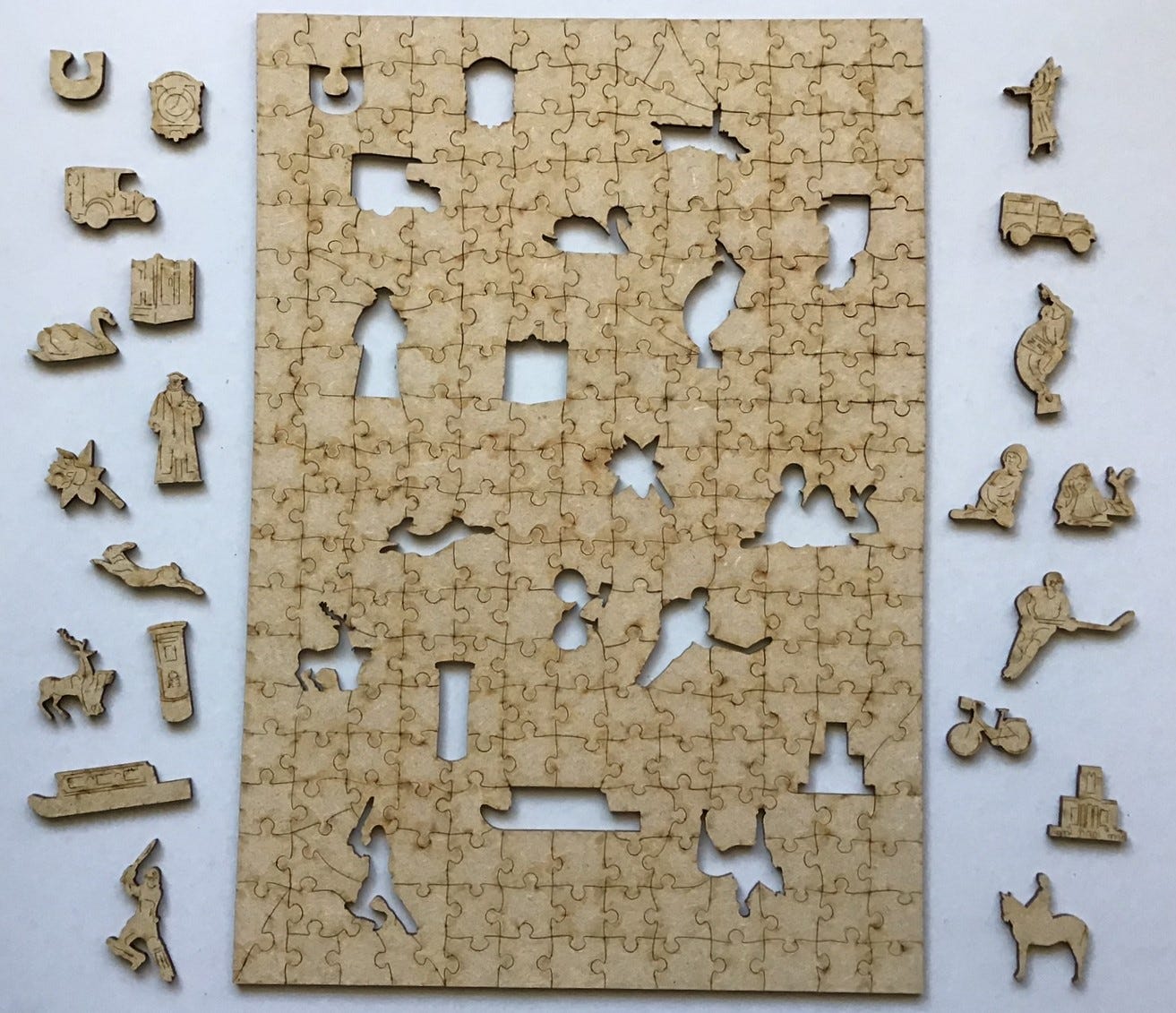
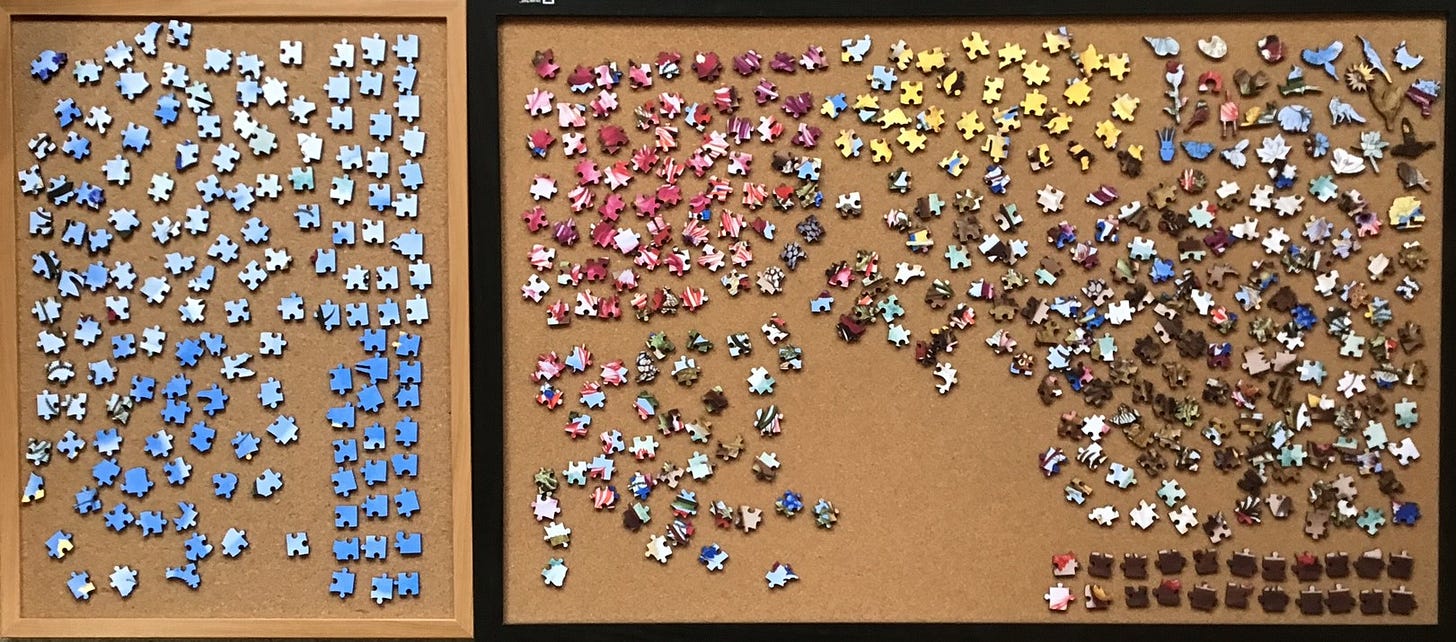
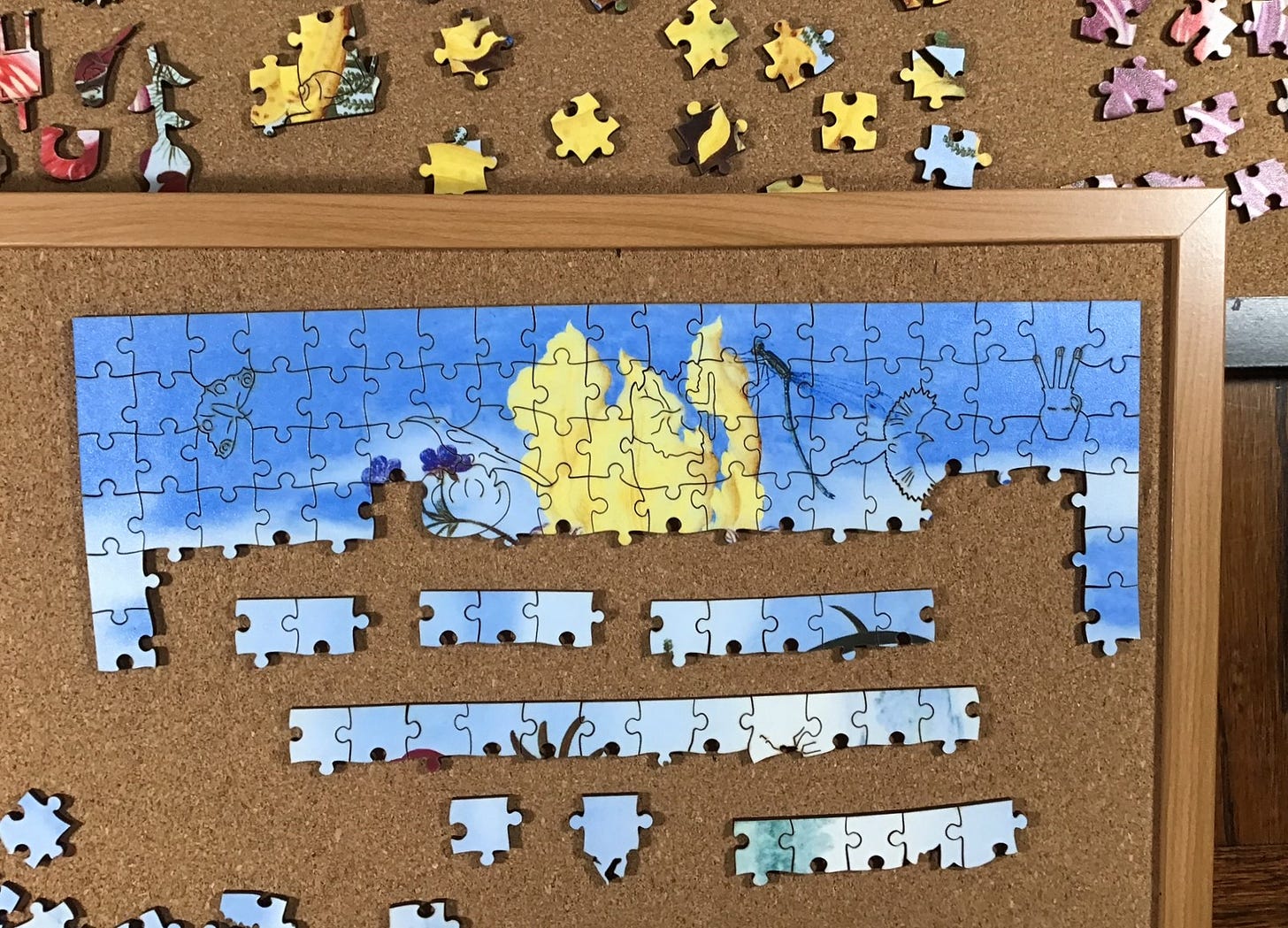

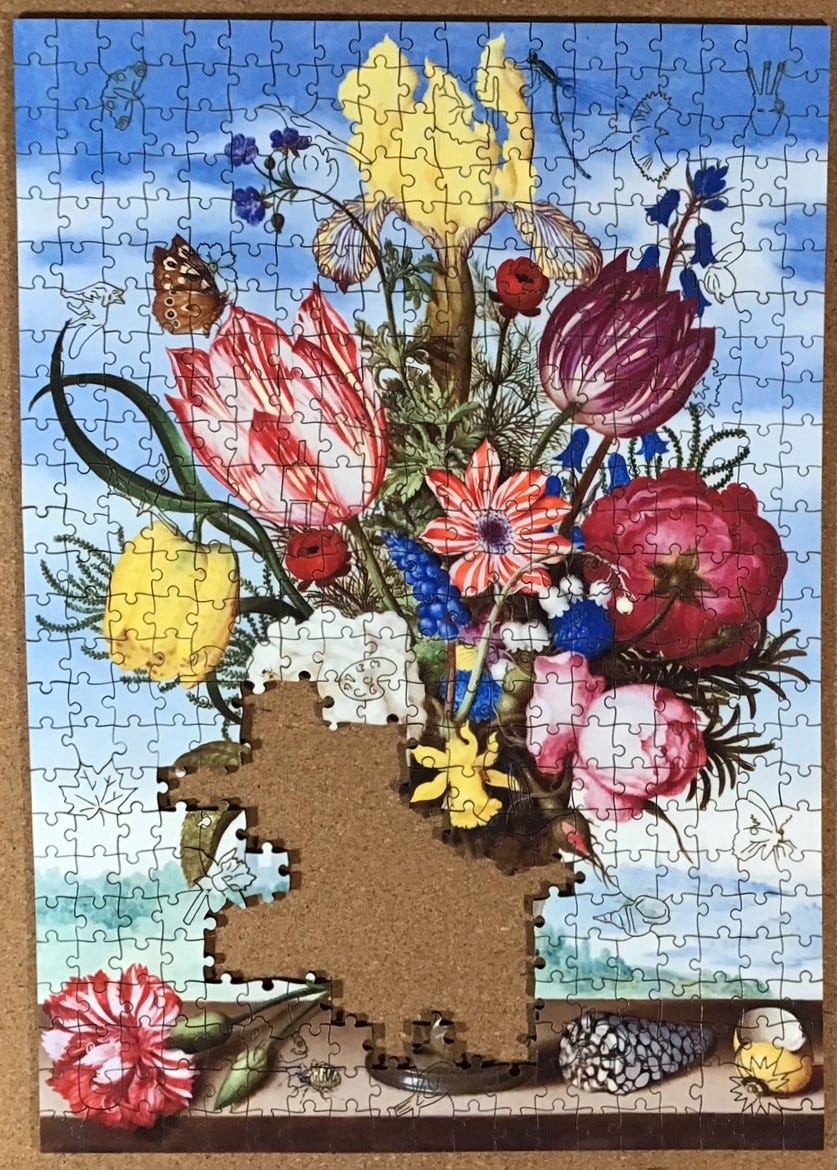
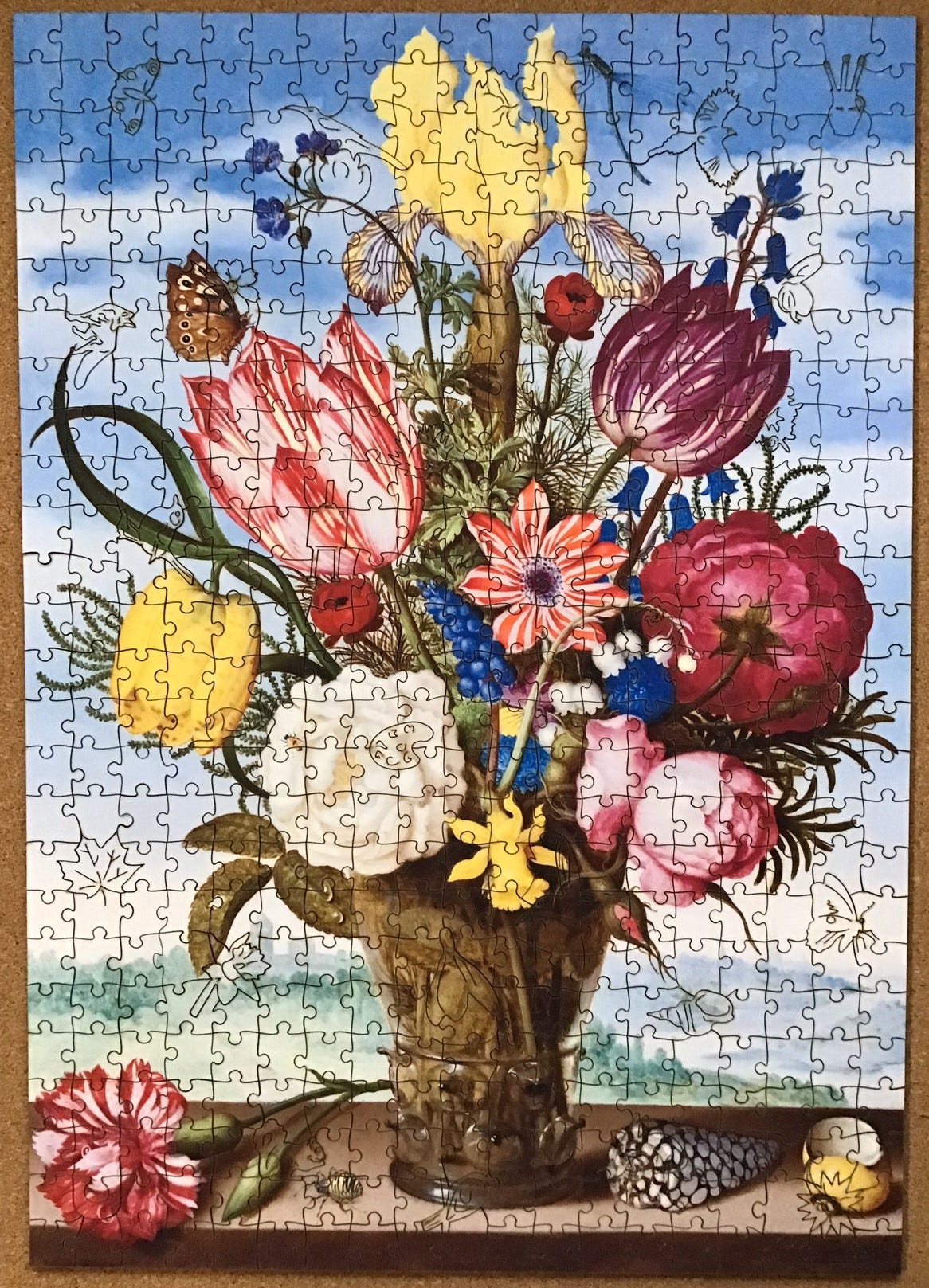

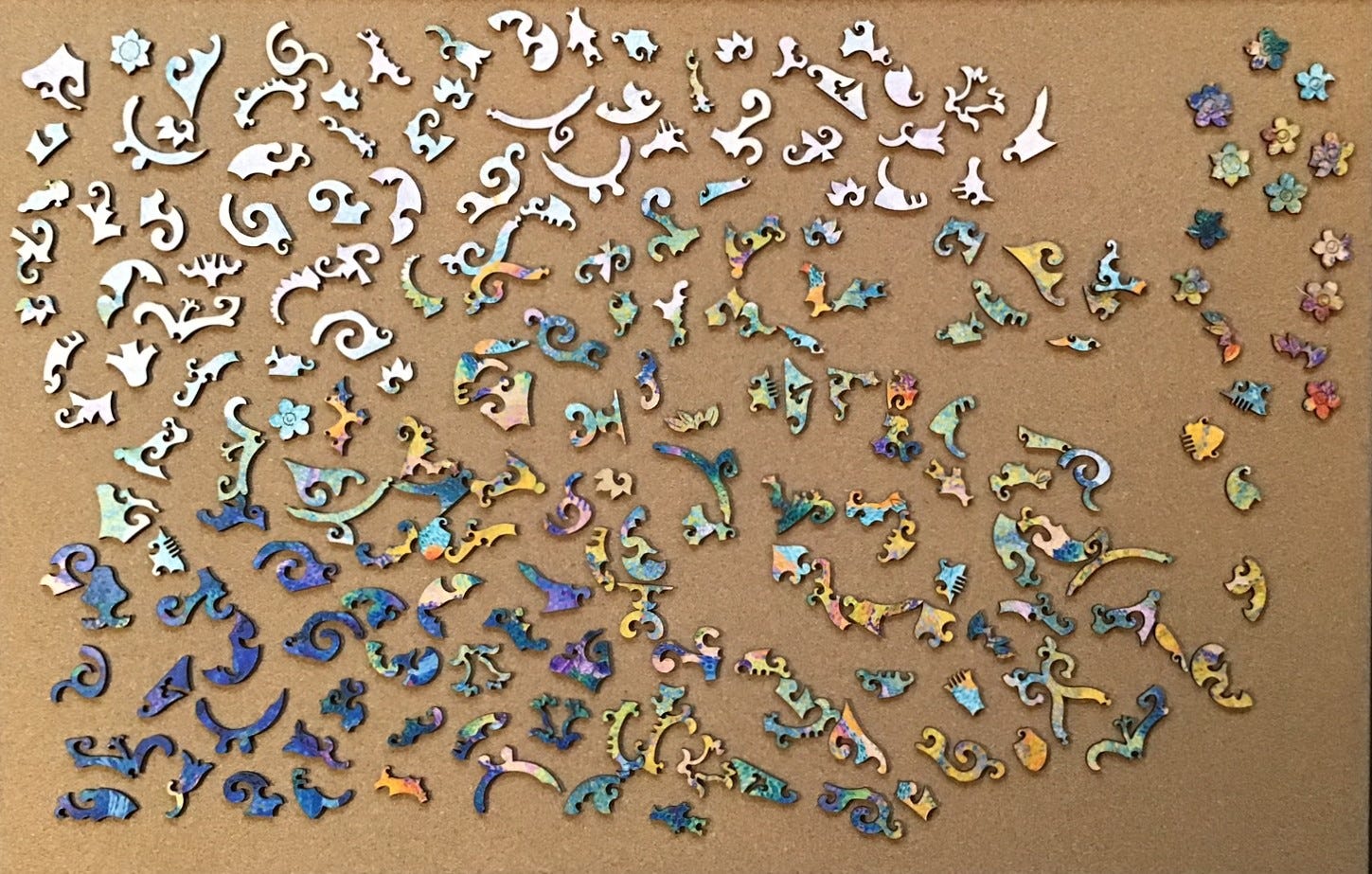
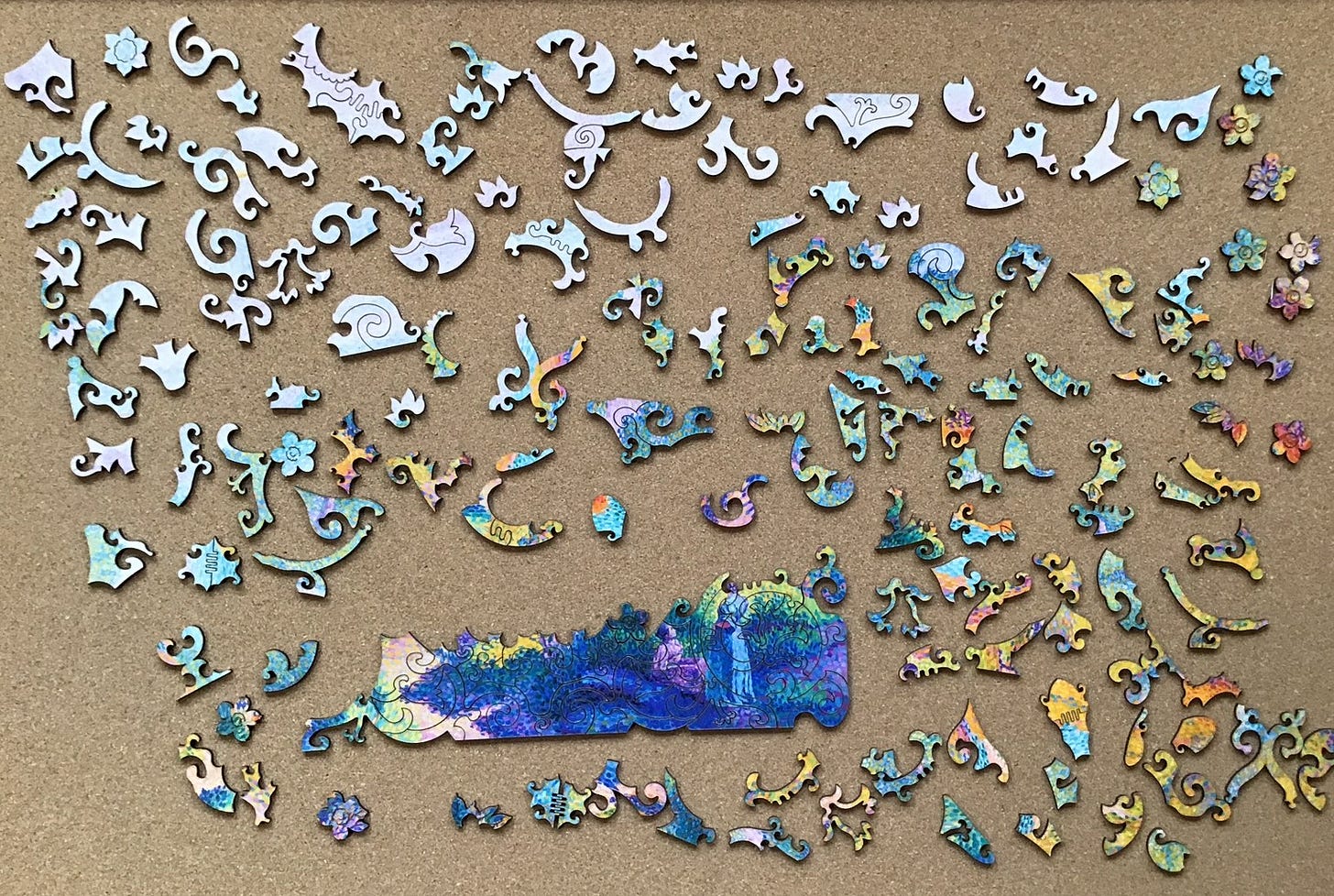
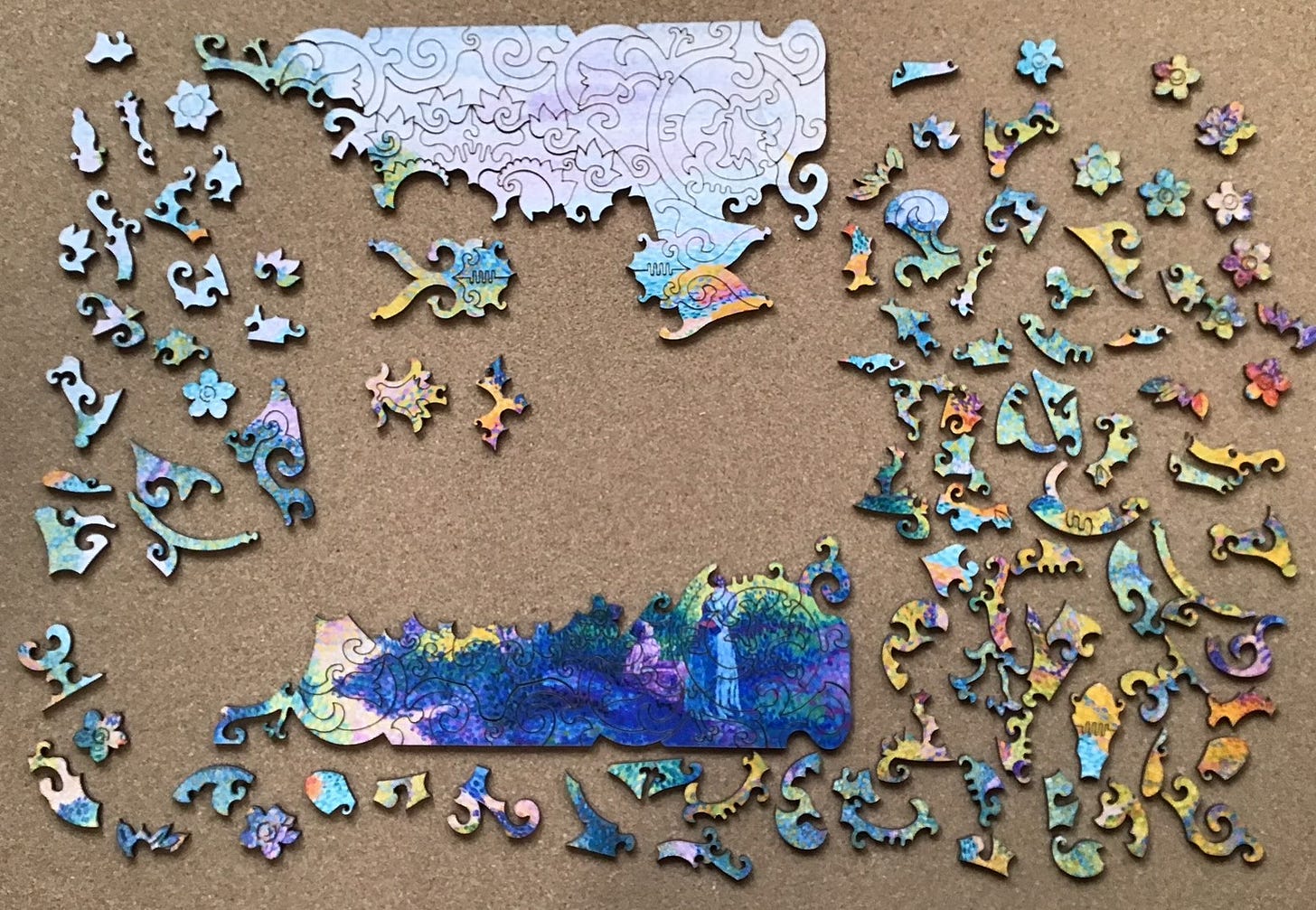
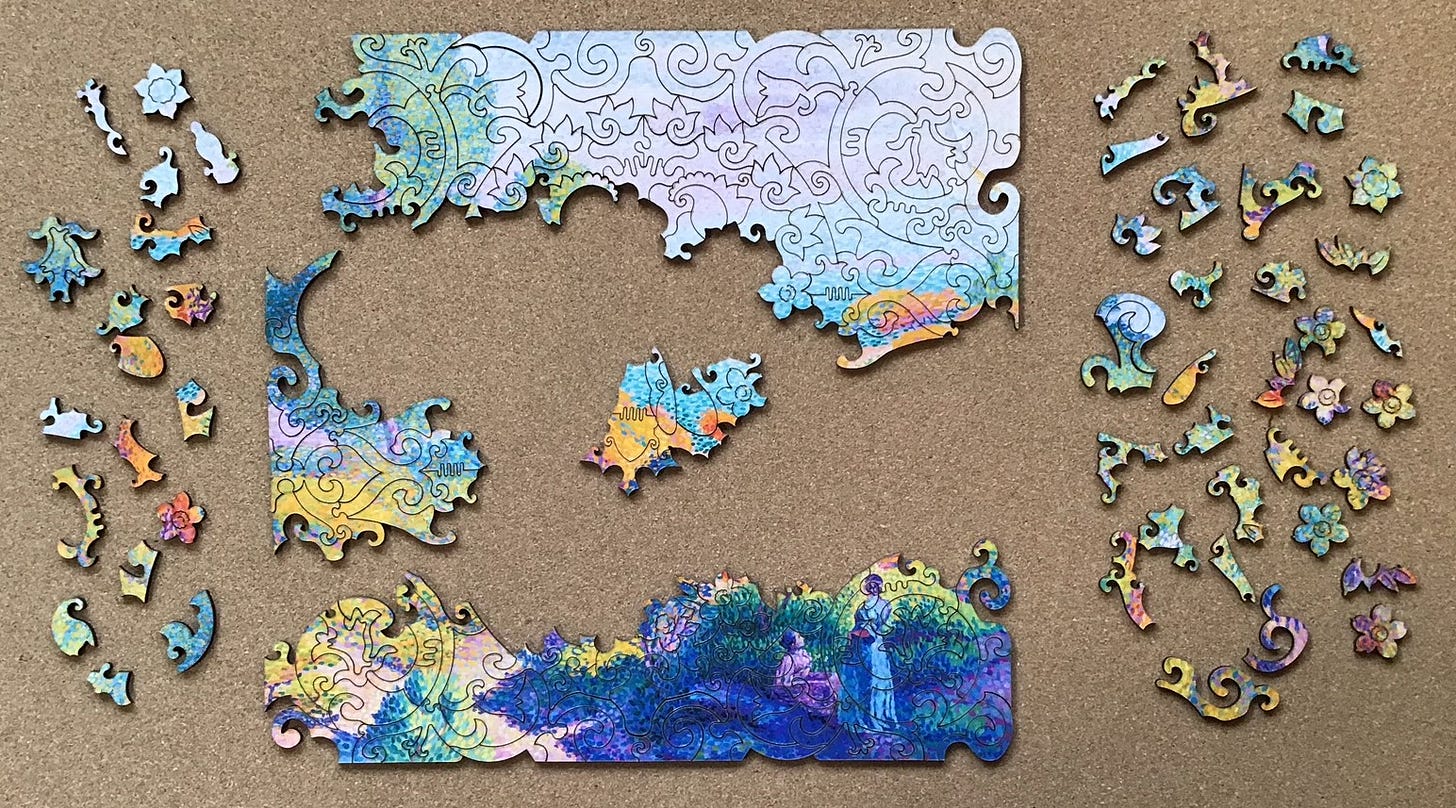

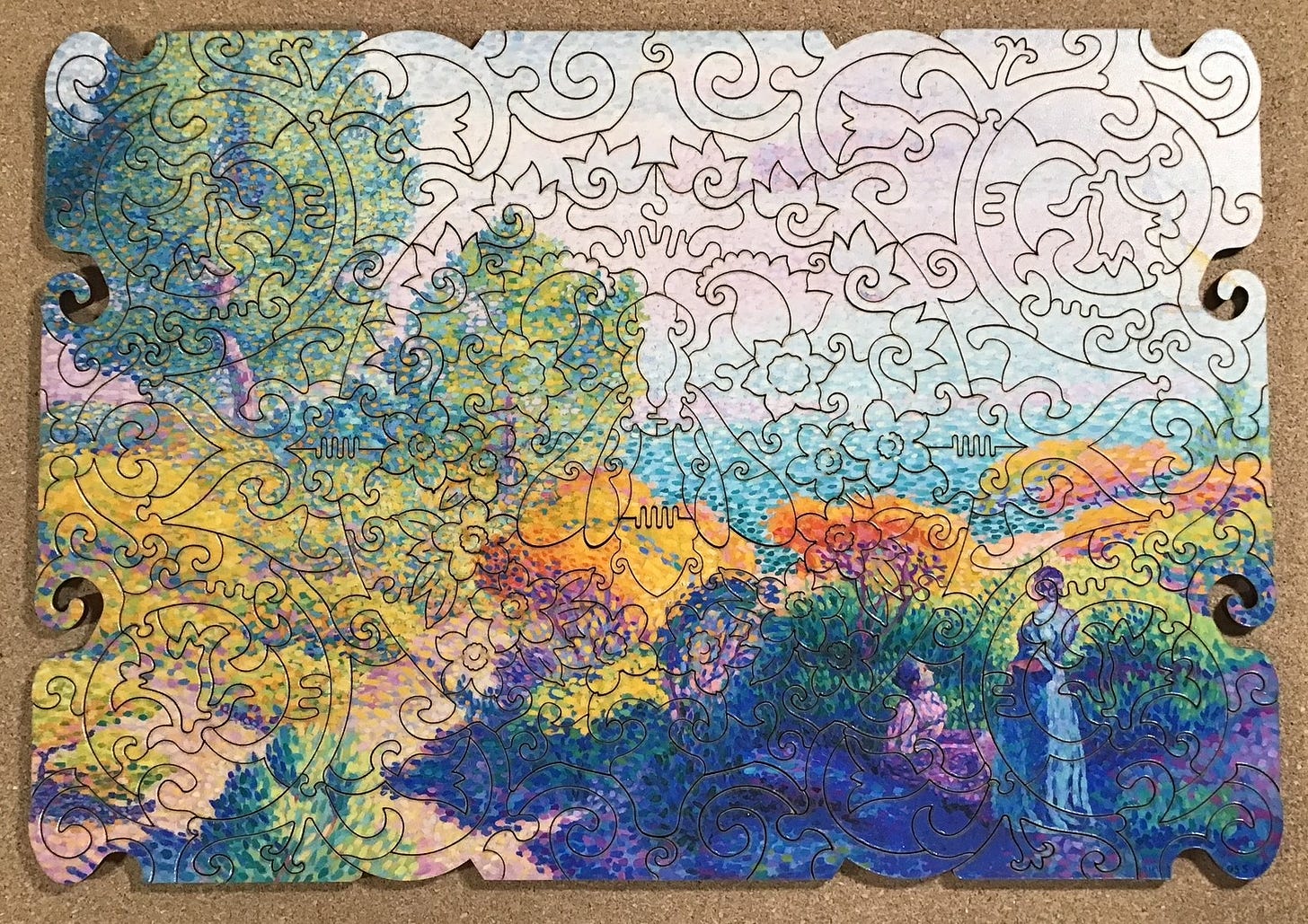
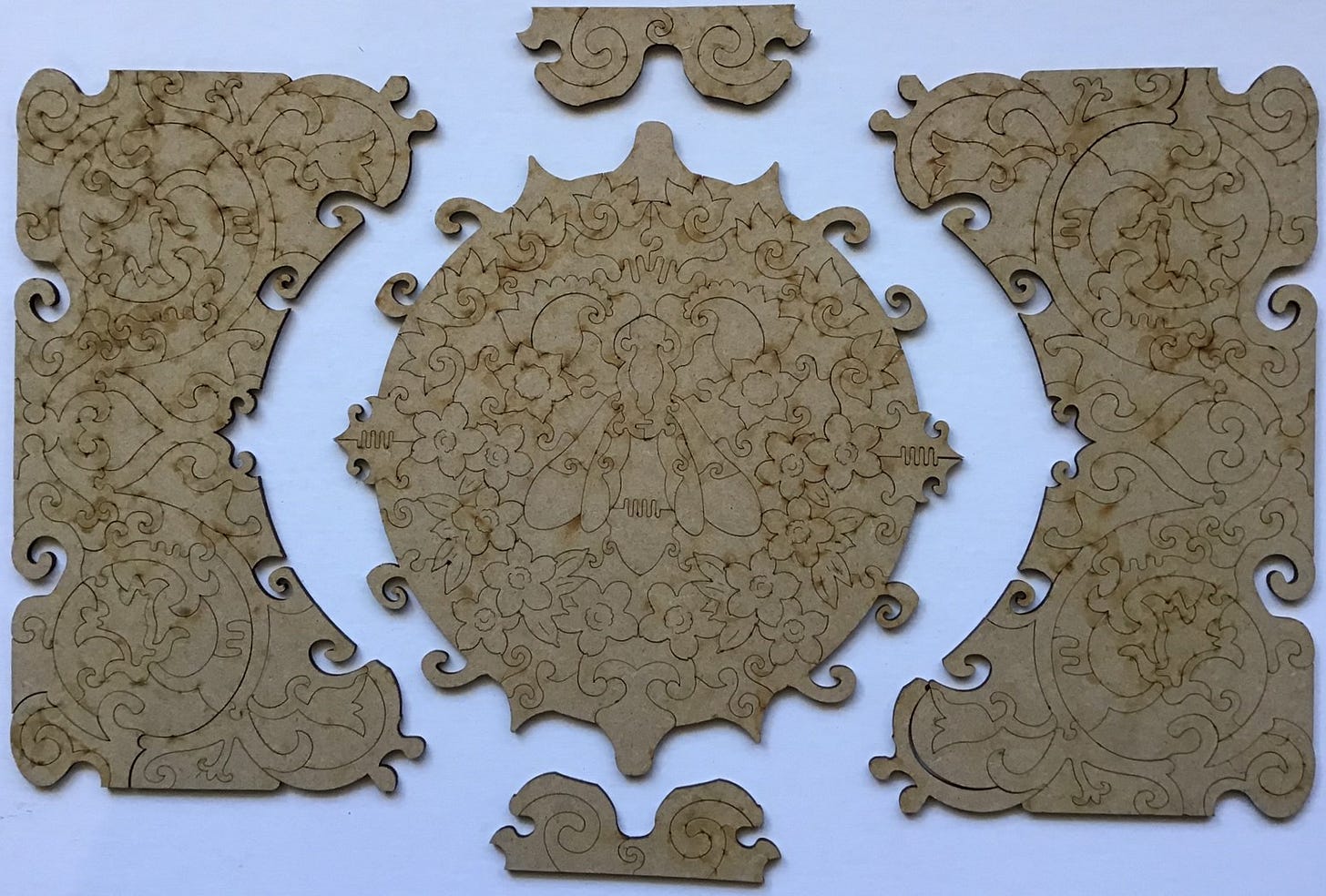
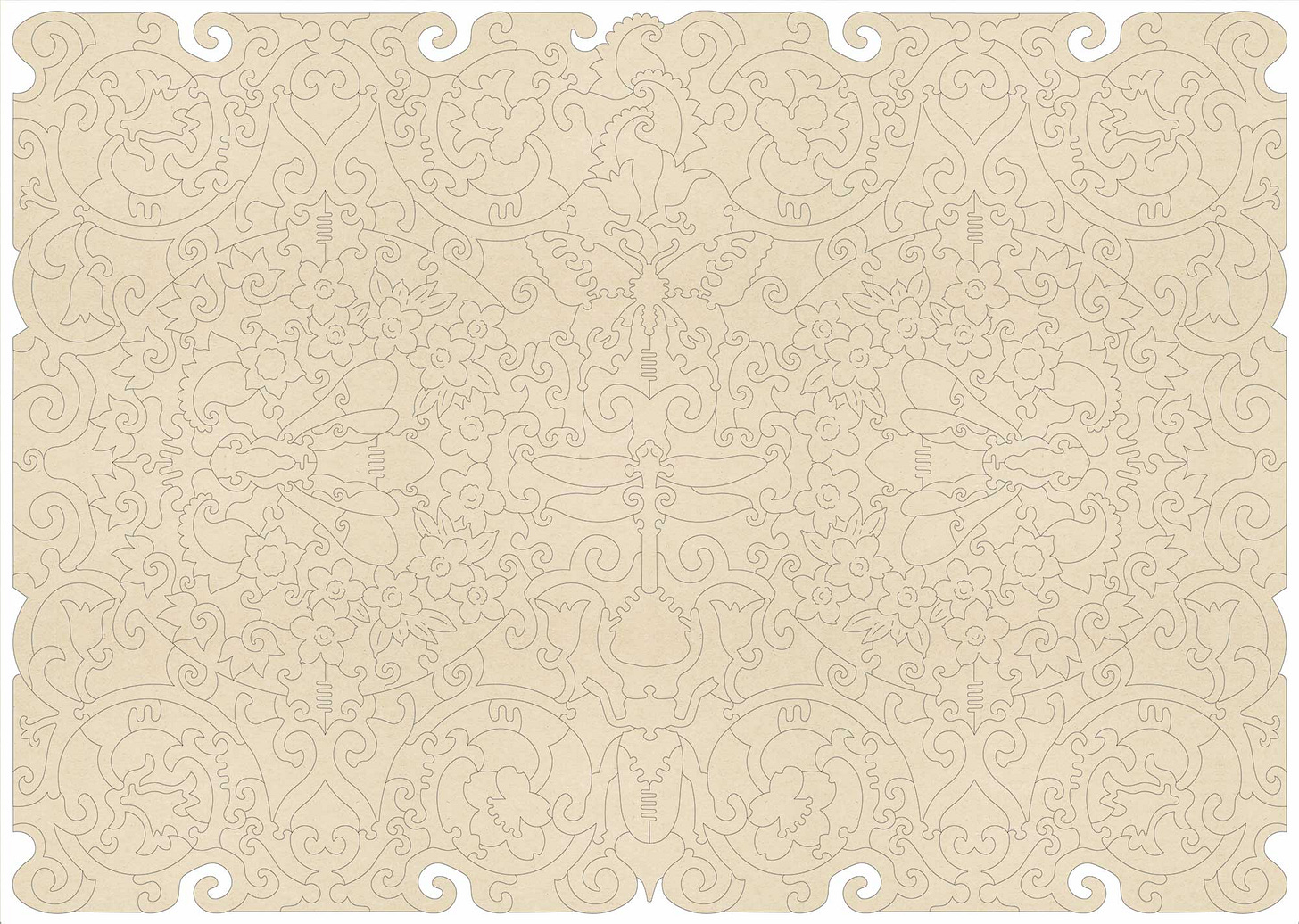
Thanks, Bill. It's nice to see your latest posting/essay. There's no need to apologize, though, for taking some time off since the last posting. My very best wishes to you re: recuperating from the eye surgery. My favourite of the three puzzle you feature today is "Flowers in a Vase," at least based on the look of its picture. I can appreciate that "Mediterranean Summer" had enjoyable complexity. For all three of these featured puzzles, I'm glad you gave us so many photos showing the progressive stages of assembly. The flipped/mirrored photos were fun for me, too, and I was pleased that I could find where the "removed" pieces fit into the views of the puzzles' fronts. I also get a kick out of the fact that you seem to develop such friendly relations with some of the makers of the puzzles you review. Thanks again for your work and thorough reporting.
Best regards,
Greg